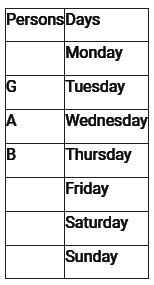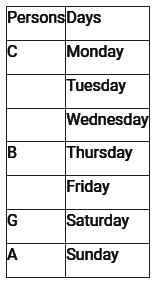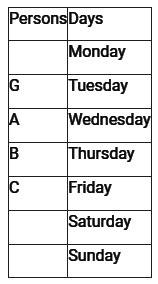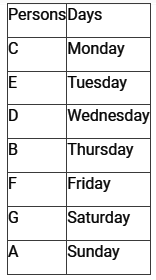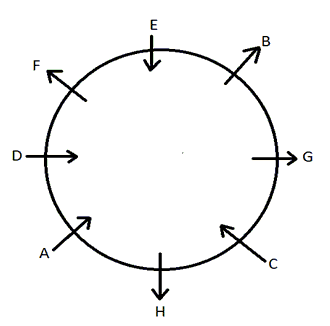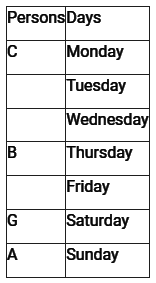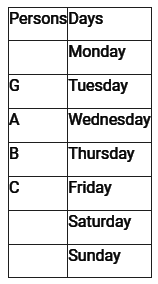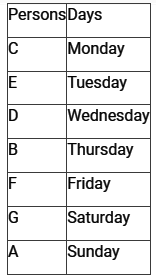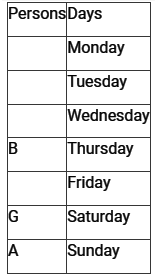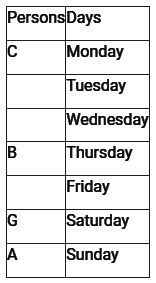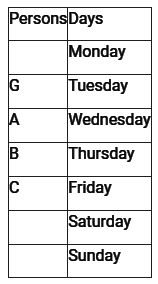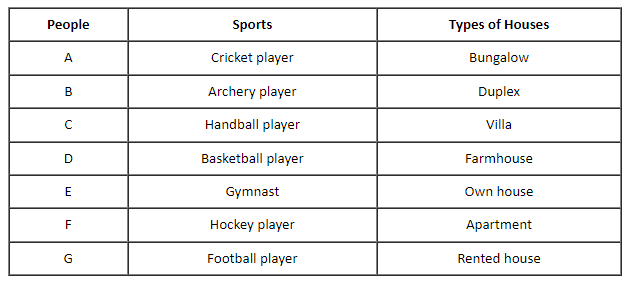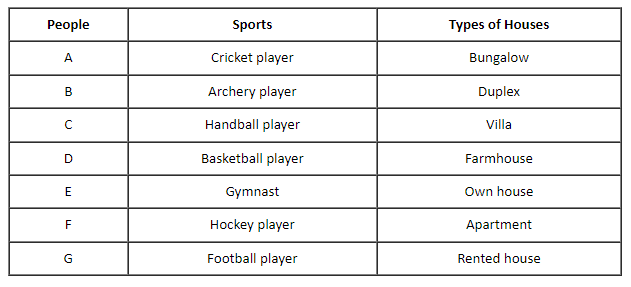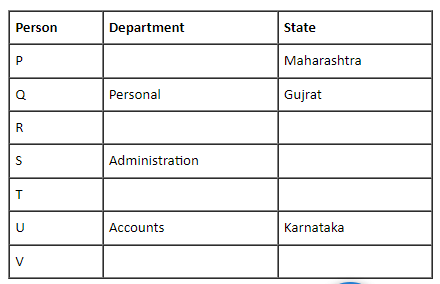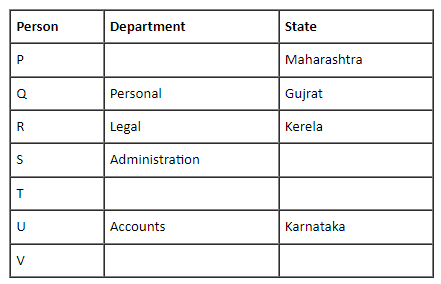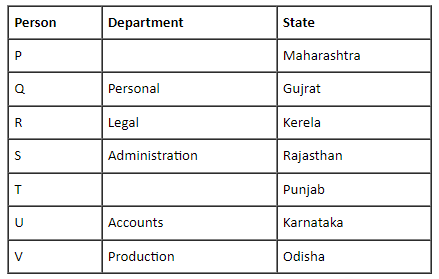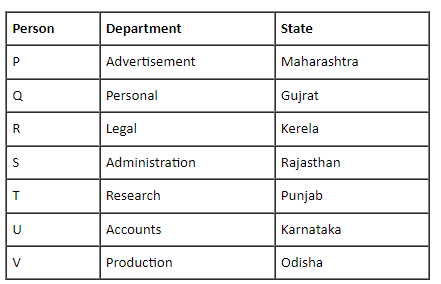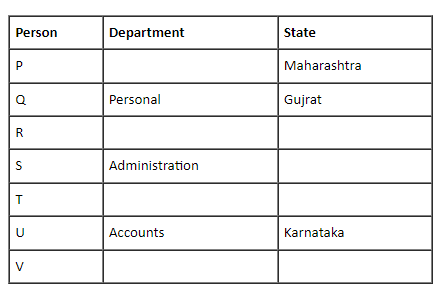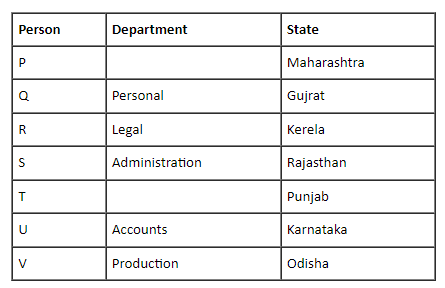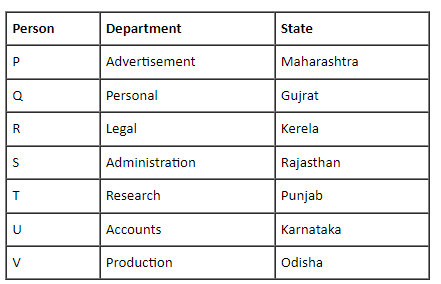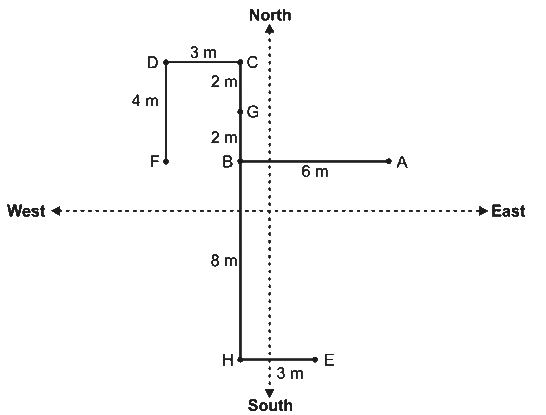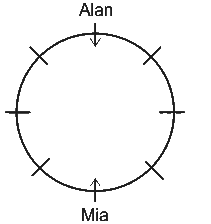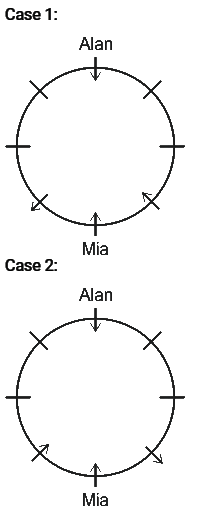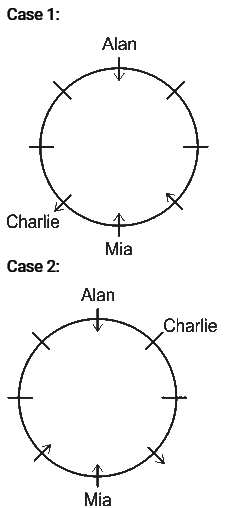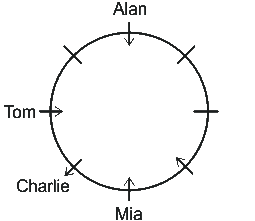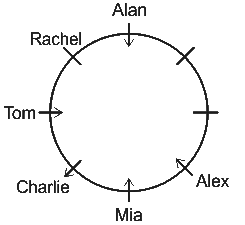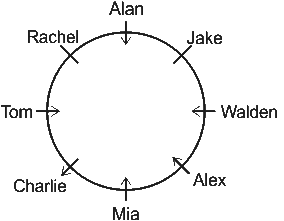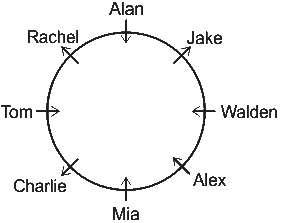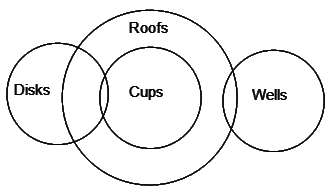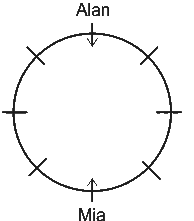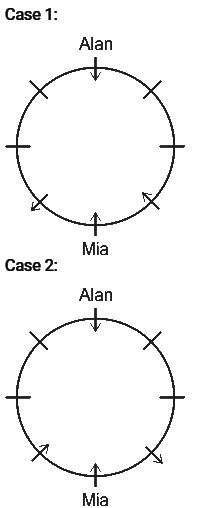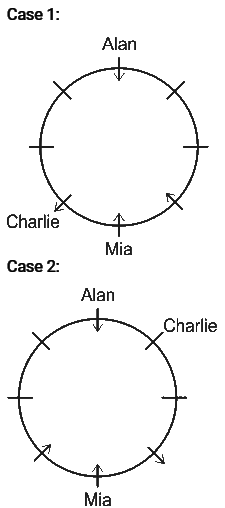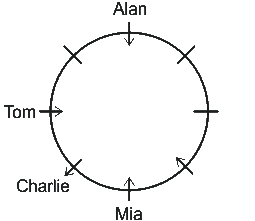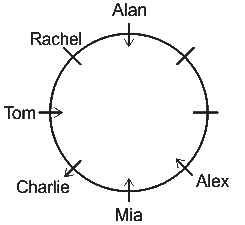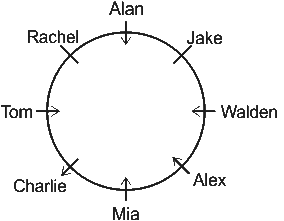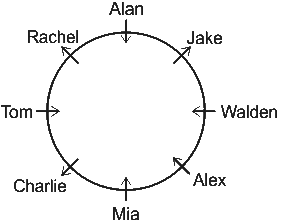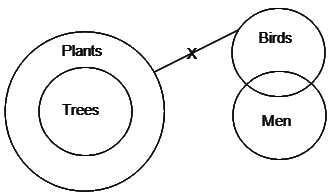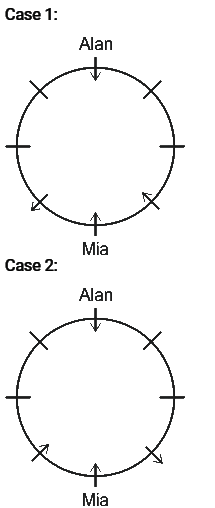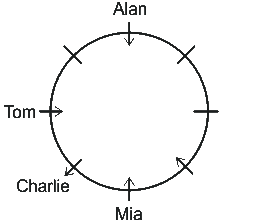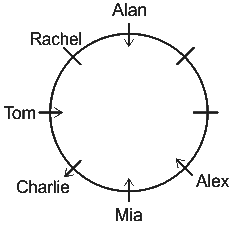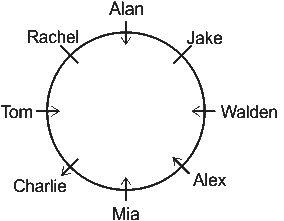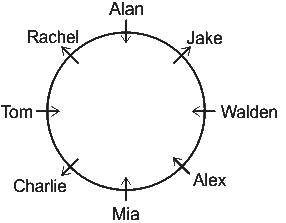IBPS SO Prelims Mock Test - 8 - Banking Exams MCQ
30 Questions MCQ Test - IBPS SO Prelims Mock Test - 8
Directions: In this question, a statement followed by two assumptions numbered I and II is given. An assumption is something supposed or taken for granted. You have to consider the statement and the assumptions and decide which of the assumptions is/are implicit in the statement.
Statement:
"We need to appoint more teachers." — Principal informs the school staff
Assumptions:
I. Teachers are available.
II. Present teachers are not good.
Directions: In the following question assuming the given statements to be true, find which of the conclusion among given conclusions is / are definitely true and then give your answers accordingly.
Statement:
V < E > R ? T = U > S < O
Conclusions:
I. R > U
II. E > S
III. R = U
Directions: Read the following passage carefully and answer the given question.
Ten persons are sitting on two benches parallel to each other. V, W, X, Y and Z are sitting on one bench facing towards south, not necessarily in the same order, and I, J, K, L and M are sitting on the other bench facing towards north, not necessarily in the same order. They are sitting in such a manner that persons on opposite benches are facing towards each other.
W is sitting just next to Y and opposite to M. X and J are sitting at the ends, which are diagonally opposite to each other. Z is sitting opposite to K, who is just next to the right of I. L is sitting just to the left of M and opposite to Y. I is sitting at the end of the bench.
Q. Who is sitting third to the right of K?
Directions: In the following question assuming the given statements to be true, find which of the conclusion among given conclusions is / are definitely true and then give your answers accordingly.
Statement:
G > R = O > C < E; R ? Y
Conclusions:
I. Y = O
II.Y > O
III. O > E
Directions: Read the following passage carefully and answer the given question.
Ten persons are sitting on two benches parallel to each other. V, W, X, Y and Z are sitting on one bench facing towards south, not necessarily in the same order, and I, J, K, L and M are sitting on the other bench facing towards north, not necessarily in the same order. They are sitting in such a manner that persons on opposite benches are facing towards each other.
W is sitting just next to Y and opposite to M. X and J are sitting at the ends, which are diagonally opposite to each other. Z is sitting opposite to K, who is just next to the right of I. L is sitting just to the left of M and opposite to Y. I is sitting at the end of the bench.
Q. From the pairs given below, find the odd one out.
Direction: The following questions are based on three digit numbers given below.
124 832 564 843 756
Q. If all digits in each number are arranged in descending order within the number, how many numbers are the same as the actual number in the new arrangement?
Directions: Read the following passage carefully and answer the given question.
Ten persons are sitting on two benches parallel to each other. V, W, X, Y and Z are sitting on one bench facing towards south, not necessarily in the same order, and I, J, K, L and M are sitting on the other bench facing towards north, not necessarily in the same order. They are sitting in such a manner that persons on opposite benches are facing towards each other.
W is sitting just next to Y and opposite to M. X and J are sitting at the ends, which are diagonally opposite to each other. Z is sitting opposite to K, who is just next to the right of I. L is sitting just to the left of M and opposite to Y. I is sitting at the end of the bench.
Q. In the arrangement given in the passage above, if the persons sitting facing towards north are said to be sitting in an alphabetical order starting from right end, then how many of them would have to shift their positions?
Direction: The following questions are based on three digit numbers given below.
124 832 564 843 756
Q. If ‘2’ is added to each of the odd digits of all numbers, which of the following number thus obtained is the highest number after this operation?
Directions: Study the following information carefully and answer the question.
A, B, C, D, E, F, G and H are sitting around a circular area at equal distances between each other, but not necessarily in the same order. Some of the people are facing the centre, while some are facing outside, i.e. in a direction opposite to the centre. H sits fourth to the left of E. D sits second to the right of H. H faces outside. A sits third to the right of G. G is not an immediate neighbour of D. A is not an immediate neighbour of E. Both the immediate neighbours of F face the centre. Both the immediate neighbours of B face opposite directions, i.e. if one person faces the centre, then the other faces outside and vice- versa. Both the immediate neighbours of H face the same direction as D, i.e. if D faces the centre, then both the immediate neighbours of H also face the centre and vice-versa. Both the immediate neighbours of E face a direction opposite to that of E, i.e. if E faces the centre, then both his immediate neighbours face outside and vice-versa.
Q. Four of the following are alike in a certain way based on the given seating arrangement and so form a group. Which of the following does not belong to this group?
Direction: Read the following information carefully and answer the questions that follow:
Seven people A, B, C, D, E, F, and G have cleared the exams on seven different days of the same week starting from Monday and ending on Sunday, but not necessarily in the same order.
B cleared the exam on Thursday. Only one person cleared the exam between C and D. F cleared the exam after D. Only one person cleared the exam between B and G. The number of people who cleared the exam before A is the same as the number of people who cleared the exam after C. A cleared the exam immediately after G.
Q. On which of the following days D cleared the exam?
Directions: Study the following information carefully and answer the question.
A, B, C, D, E, F, G and H are sitting around a circular area at equal distances between each other, but not necessarily in the same order. Some of the people are facing the centre, while some are facing outside, i.e. in a direction opposite to the centre. H sits fourth to the left of E. D sits second to the right of H. H faces outside. A sits third to the right of G. G is not an immediate neighbour of D. A is not an immediate neighbour of E. Both the immediate neighbours of F face the centre. Both the immediate neighbours of B face opposite directions, i.e. if one person faces the centre, then the other faces outside and vice- versa. Both the immediate neighbours of H face the same direction as D, i.e. if D faces the centre, then both the immediate neighbours of H also face the centre and vice-versa. Both the immediate neighbours of E face a direction opposite to that of E, i.e. if E faces the centre, then both his immediate neighbours face outside and vice-versa.
Q. Who is sitting to the immediate left of E?
Direction: Read the following information carefully and answer the questions that follow:
Seven people A, B, C, D, E, F, and G have cleared the exams on seven different days of the same week starting from Monday and ending on Sunday, but not necessarily in the same order.
B cleared the exam on Thursday. Only one person cleared the exam between C and D. F cleared the exam after D. Only one person cleared the exam between B and G. The number of people who cleared the exam before A is the same as the number of people who cleared the exam after C. A cleared the exam immediately after G.
Q. Who among the following has cleared the exam on Tuesday?
Directions: Study the following information carefully and answer the question given below.
There are seven people A, B, C, D, E, F and G. These people are Hockey player, Gymnast, Archery player, Cricket player, Football player, Handball player and Basketball player, but not necessarily in the same order. They live in seven different types of houses, i.e. own house, rented house, villa, farmhouse, bungalow, duplex and apartment, but not necessarily in the same order.
A lives in bungalow. D is a Basketball player. The person who is a Football player lives in rented house. The person who is an Archery player lives in duplex. F does not live in duplex, rented house, own house or farmhouse.
F is neither a Handball player, nor a Gymnast, nor a Cricket player. B does not live in villa, rented house, own house or farmhouse. C is not a Football player and he does not live in farmhouse or own house. Neither D nor G lives in own house. A is not a Gymnast. The person from villa is a Handball player.
Q. Who among the following is a Handball player?
Direction: Read the following information carefully and answer the questions that follow:
Seven people A, B, C, D, E, F, and G have cleared the exams on seven different days of the same week starting from Monday and ending on Sunday, but not necessarily in the same order.
B cleared the exam on Thursday. Only one person cleared the exam between C and D. F cleared the exam after D. Only one person cleared the exam between B and G. The number of people who cleared the exam before A is the same as the number of people who cleared the exam after C. A cleared the exam immediately after G.
Q. If every person is cleared the exam in alphabetical order from Monday to Sunday, the day of clearing the exam of how many people will remain unchanged?
Directions: Study the following information carefully and answer the question given below.
There are seven people A, B, C, D, E, F and G. These people are Hockey player, Gymnast, Archery player, Cricket player, Football player, Handball player and Basketball player, but not necessarily in the same order. They live in seven different types of houses, i.e. own house, rented house, villa, farmhouse, bungalow, duplex and apartment, but not necessarily in the same order.
A lives in bungalow. D is a Basketball player. The person who is a Football player lives in rented house. The person who is an Archery player lives in duplex. F does not live in duplex, rented house, own house or farmhouse.
F is neither a Handball player, nor a Gymnast, nor a Cricket player. B does not live in villa, rented house, own house or farmhouse. C is not a Football player and he does not live in farmhouse or own house. Neither D nor G lives in own house. A is not a Gymnast. The person from villa is a Handball player.
Q. Who among the following lives in an apartment?
Directions: The question below consists of questions and two statements numbered I and II given below it. You have to decide whether the data provided in the statements are sufficient to answer the question. Read both the statements and give answer.
How is N related to K?
I. N’s brother is married to D.
II. D’s sister is married to K.
Directions: Study the following information carefully and answer the question given below.
There are seven people A, B, C, D, E, F and G. These people are Hockey player, Gymnast, Archery player, Cricket player, Football player, Handball player and Basketball player, but not necessarily in the same order. They live in seven different types of houses, i.e. own house, rented house, villa, farmhouse, bungalow, duplex and apartment, but not necessarily in the same order.
A lives in bungalow. D is a Basketball player. The person who is a Football player lives in rented house. The person who is an Archery player lives in duplex. F does not live in duplex, rented house, own house or farmhouse.
F is neither a Handball player, nor a Gymnast, nor a Cricket player. B does not live in villa, rented house, own house or farmhouse. C is not a Football player and he does not live in farmhouse or own house. Neither D nor G lives in own house. A is not a Gymnast. The person from villa is a Handball player.
Q. The person who lives in own house is a
Directions: Study the following information carefully and answer the questions following it.
Eight friends Arvind, Vishwas, Dhananjay, Javed, Rahul, Sharad, Smriti, Sushil are sitting in a row facing north direction. Sharad is sitting at a fourth position from the right end of the row. Smriti is the neighbour of Rahul and Arvind. Sushil is immediate neighbour of Sharad. Dhananjay is not an immediate neighbour of Sushil. Vishwas is sitting at extreme left end and Rahul is his neighbour.
Q. Who is sitting at the immediate left of Sharad?
Directions: Study the following information carefully and answer the question given below.
Seven people P, Q, R, S, T, U and V are working in the same company but in seven different departments, viz. Accounts, Research, Personal, Advertising, Production, Legal and Administration, but not necessarily in the same order. Each of them is working in different states, viz. Punjab, Odisha, Kerala, Rajasthan, Maharashtra, Gujarat and Karnataka, but not necessarily in the same order.
P works in Maharashtra. S works in Administration department. The person who works in Production department is working in Odisha. The person who works in Personal department works in Gujarat. U does not work in Gujarat, Odisha, Punjab or Rajasthan. U does not work in Legal, Research or Advertisement department. Q is not working in Kerala, Odisha, Punjab or Rajasthan. Q is not working in Advertisement, Accounts, Research or Legal department. R is not working in Production department and not in Rajasthan or Punjab. Neither S nor V works in Punjab. P does not work in Research department. The person, who works in Kerala, works in Legal department.
Q. According to the information given in the passage, which of the following combinations is/are correct?
Directions: Study the following information carefully and answer the questions following it.
Eight friends Arvind, Vishwas, Dhananjay, Javed, Rahul, Sharad, Smriti, Sushil are sitting in a row facing north direction. Sharad is sitting at a fourth position from the right end of the row. Smriti is the neighbour of Rahul and Arvind. Sushil is immediate neighbour of Sharad. Dhananjay is not an immediate neighbour of Sushil. Vishwas is sitting at extreme left end and Rahul is his neighbour.
Q. What is the position of Javed with respect to Smriti?
Directions: Study the following information carefully and answer the question given below.
Seven people P, Q, R, S, T, U and V are working in the same company but in seven different departments, viz. Accounts, Research, Personal, Advertising, Production, Legal and Administration, but not necessarily in the same order. Each of them is working in different states, viz. Punjab, Odisha, Kerala, Rajasthan, Maharashtra, Gujarat and Karnataka, but not necessarily in the same order.
P works in Maharashtra. S works in Administration department. The person who works in Production department is working in Odisha. The person who works in Personal department works in Gujarat. U does not work in Gujarat, Odisha, Punjab or Rajasthan. U does not work in Legal, Research or Advertisement department. Q is not working in Kerala, Odisha, Punjab or Rajasthan. Q is not working in Advertisement, Accounts, Research or Legal department. R is not working in Production department and not in Rajasthan or Punjab. Neither S nor V works in Punjab. P does not work in Research department. The person, who works in Kerala, works in Legal department.
Q. Which of the following combinations is correct for V?
Directions: Read the following information carefully and answer the questions which follow:
Point B is 6 m to the west of point A. Point C is 4 m north of point B. Point G is exactly midway between point B and point C. Point H is 12 m south of point C. Point D is 3 m to the west of point C and point F is 4 m south of point D. Point E is 3 m to the east of point H.
Q. Which is the odd one out?
If the first six letters of the word "EXTRAORDINARY" were written in reverse order and the last six letters were also written in reverse order, which would be fifth letter to the left of N?
Directions: Read the instructions carefully and answer the question below
There are four cars namely A, B, C and D having different speeds and prices. Car D is costlier than car C but its speed is lesser than car C. Car A is costlier than car D but cheaper than car B. Speed of car A is higher than car B and C.
Q. Which of the following cars is costlier than others?
Directions: In the following problem, a question is followed by statements I, II and III. Read all the statements carefully and find out which of them is/are sufficient to answer the given question. Choose the correct alternative.
How is the girl in the photograph related to Prashant(male)?
Statements:
I. Pointing to a photograph, Prashant said, ''She is the mother of my father's only granddaughter.''
II. Prashant has no siblings.
III. Pointing to the photograph, Prashant said, ''She is the only daughter-in-law of my mother who has only one child''
Directions: Study the following information carefully and answer the question that follows:
Eight persons Alex, Rachel, Charlie, Walden, Jake, Tom, Mia, Alan are sitting around the circular table not necessarily in the same order. Three of them are facing away from the centre and the remaining towards the centre.
Tom and Charlie are neighbors, facing in the opposite direction. Alex is not immediate neighbor of Alan. Walden does not sit opposite to Charlie. Alan and Mia are facing each other. Rachel and Alex are sitting opposite to each other. The immediate neighbors of Mia are facing in opposite direction. Charlie and Alan are not immediate neighbors. Charlie is second to the left of the person sitting third to the left of Alan. Walden is facing in the same direction as Alex.
Q. What is the position of Alex with respect to Charlie?
Directions: Three statements followed by three conclusions are given below. You have to take the given statements to be true even if they seem to be at variance from commonly known facts. Read all the conclusions and decide which of the following conclusions logically follows the given statements disregarding commonly known facts.
Statements:
Some disks are cups.
All cups are roofs.
Some roofs are wells.
Conclusions:
I. Some roofs are disks.
II. Some wells are cups.
III. Some roofs are cups.
Directions: Study the following information carefully and answer the question that follows:
Eight persons Alex, Rachel, Charlie, Walden, Jake, Tom, Mia, Alan are sitting around the circular table not necessarily in the same order. Three of them are facing away from the centre and the remaining towards the centre.
Tom and Charlie are neighbors, facing in the opposite direction. Alex is not immediate neighbor of Alan. Walden does not sit opposite to Charlie. Alan and Mia are facing each other. Rachel and Alex are sitting opposite to each other. The immediate neighbors of Mia are facing in opposite direction. Charlie and Alan are not immediate neighbors. Charlie is second to the left of the person sitting third to the left of Alan. Walden is facing in the same direction as Alex.
Q. Who is facing Walden?
Directions: Three statements followed by three conclusions are given below. You have to take the given statements to be true even if they seem to be at variance from commonly known facts. Read all the conclusions and decide which of the following conclusions logically follow(s) the given statements disregarding commonly known facts.
Statements:
All trees are plants.
No plant is bird.
Some birds are men.
Conclusions:
I. Some men are plants.
II. Some birds are trees.
III. Some men are trees.
Directions: Study the following information carefully and answer the question that follows:
Eight persons Alex, Rachel, Charlie, Walden, Jake, Tom, Mia, Alan are sitting around the circular table not necessarily in the same order. Three of them are facing away from the centre and the remaining towards the centre.
Tom and Charlie are neighbors, facing in the opposite direction. Alex is not immediate neighbor of Alan. Walden does not sit opposite to Charlie. Alan and Mia are facing each other. Rachel and Alex are sitting opposite to each other. The immediate neighbors of Mia are facing in opposite direction. Charlie and Alan are not immediate neighbors. Charlie is second to the left of the person sitting third to the left of Alan. Walden is facing in the same direction as Alex.
Q. Who among the following is an immediate neighbour of Tom?








